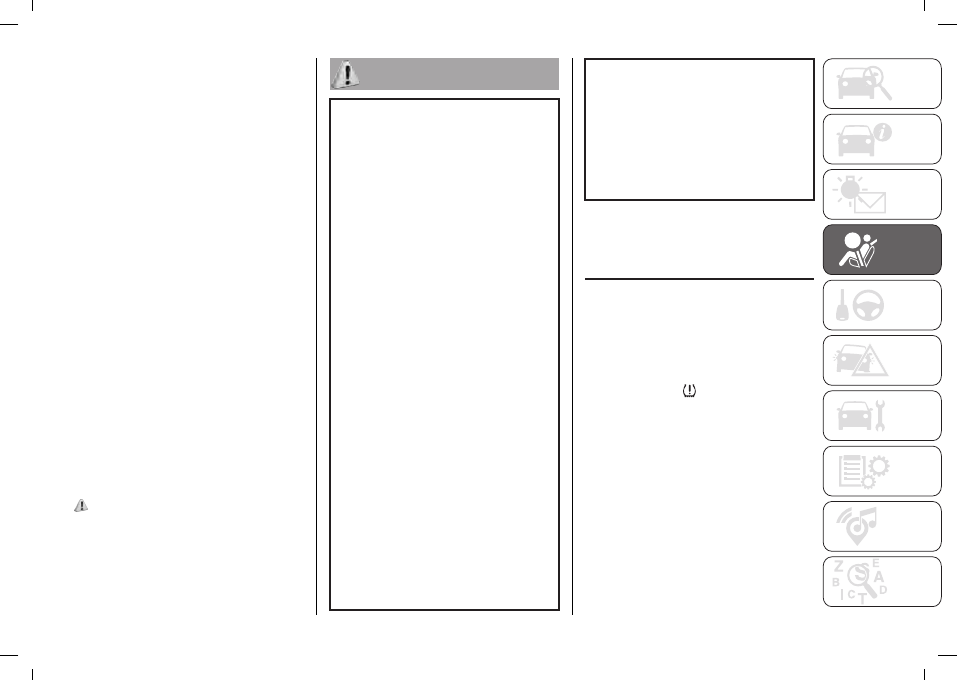Fiat Qubo (2021 year). Manual in english - page 7

107
HYDRAULIC BRAKE
ASSIST (assistance
during emergency
braking)
(for versions/markets, where provided)
The HBA system is an integral part
of the ESC system and is designed
to improve the vehicle’s braking
capacity during emergency braking.
The system detects emergency braking
by monitoring the speed and force with
which the brake pedal is pressed, and
consequently applies the optimal brake
pressure. This can reduce the braking
distance: the HBA system therefore
completes the ABS.
Maximum assistance of the HBA
system is obtained pressing the
brake pedal very quickly; in addition,
the brake pedal should be pressed
continuously during braking, avoiding
intermittent presses, to obtain benefits
from the system. Do not reduce
pressure on the brake pedal until
braking is no longer necessary.
The HBA system is deactivated when
the brake pedal is released.
65) 66) 67)
57)
The ESC system cannot overrule
the natural laws of physics, and can’t
increase the grip available according to the
condition of the road.
58)
The ESC system cannot prevent
accidents, including those due to
excessive speed on corners, driving on
low-grip surfaces or aquaplaning.
59)
The capability of the ESC system
must never be tested irresponsibly
and dangerously, in such a way as to
compromise personal safety and the
safety of others.
60)
For the correct operation of the ESC
and ASR systems it is vital that the tyres
are the same make and the same type on
all the wheels, in perfect condition and,
above all, the recommended type and size.
61)
The ASR cannot overrule the natural
laws of physics, and cannot increase the
grip available according to the condition of
the road.
62)
The ASR system cannot prevent
accidents, including those due to
excessive speed on corners, driving on
low-grip surfaces or aquaplaning.
63)
The capability of the ASR must never
be tested irresponsibly and dangerously,
in such a way as to compromise personal
safety and the safety of others.
64)
Do not take unnecessary risks, even if
your vehicle is fitted with this system. Your
driving style must always be suited to the
road conditions, visibility and traffic. The
driver is always responsible for road safety.
65)
The HBA system cannot overrule
the natural laws of physics, and cannot
increase the grip available according to the
condition of the road.
66)
The HBA system cannot prevent
accidents, including those due to
excessive speed on corners, driving on
low-grip surfaces or aquaplaning.
67)
The capability of the HBA must never
be tested irresponsibly and dangerously,
in such a way as to compromise personal
safety and the safety of others.
iTPMS (indirect
Tyre Pressure
Monitoring System)
(for versions/markets, where provided)
The indirect Tyre Pressure Monitoring
System iTPMS can monitor the tyre
inflation status through the wheel
speed sensors. The system warns the
driver if one or more tyres are flat by
switching on the warning light on
the instrument panel and a warning
message on the display dedicated with
an acoustic signal.
It is advisable to check the pressure
of all four tyres. This indication is
displayed also when turning the engine
off and on until the “Reset” procedure
is carried out.
“Reset” procedure
The iTPMS needs an initial "self-
learning" phase (with length depending
on the driving style and road
conditions: optimal conditions being